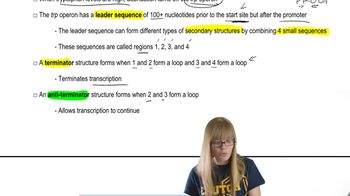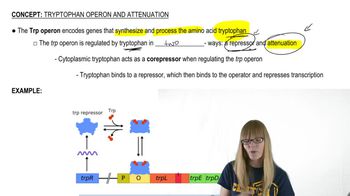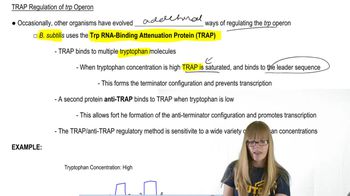Table of contents
- 1. Introduction to Genetics51m
- 2. Mendel's Laws of Inheritance3h 37m
- 3. Extensions to Mendelian Inheritance2h 41m
- 4. Genetic Mapping and Linkage2h 28m
- 5. Genetics of Bacteria and Viruses1h 21m
- 6. Chromosomal Variation1h 48m
- 7. DNA and Chromosome Structure56m
- 8. DNA Replication1h 10m
- 9. Mitosis and Meiosis1h 34m
- 10. Transcription1h 0m
- 11. Translation58m
- 12. Gene Regulation in Prokaryotes1h 19m
- 13. Gene Regulation in Eukaryotes44m
- 14. Genetic Control of Development44m
- 15. Genomes and Genomics1h 50m
- 16. Transposable Elements47m
- 17. Mutation, Repair, and Recombination1h 6m
- 18. Molecular Genetic Tools19m
- 19. Cancer Genetics29m
- 20. Quantitative Genetics1h 26m
- 21. Population Genetics50m
- 22. Evolutionary Genetics29m
12. Gene Regulation in Prokaryotes
Tryptophan Operon and Attenuation
Problem 25e
Textbook Question
What is the likely effect of each of the following mutations of the trpL region on attenuation control of trp operon gene transcription? Explain your reasoning. The entire polypeptide coding sequence of trpL is deleted.
 Verified step by step guidance
Verified step by step guidance1
Understand the role of the trpL region in the trp operon. The trpL region contains the leader peptide sequence and is involved in the attenuation mechanism, which regulates the transcription of the trp operon based on tryptophan levels.
Recognize that the leader peptide sequence in the trpL region is crucial for the formation of the attenuator structure. This structure can form a terminator or anti-terminator hairpin in the mRNA, influencing whether transcription continues or stops.
Consider the effect of deleting the entire polypeptide coding sequence of trpL. Without the leader peptide, the ribosome cannot stall at the tryptophan codons, which is necessary for the formation of the anti-terminator structure when tryptophan levels are low.
Predict that the deletion of the trpL coding sequence would likely disrupt the attenuation mechanism. Without the leader peptide, the ribosome cannot properly regulate the formation of the terminator or anti-terminator structures, potentially leading to unregulated transcription of the trp operon.
Conclude that the deletion of the trpL region would likely result in constitutive expression of the trp operon, as the attenuation control mechanism would be impaired, allowing transcription to proceed regardless of tryptophan levels.
Recommended similar problem, with video answer:
 Verified Solution
Verified SolutionThis video solution was recommended by our tutors as helpful for the problem above
Video duration:
2mPlay a video:
Was this helpful?
Key Concepts
Here are the essential concepts you must grasp in order to answer the question correctly.
Attenuation Control
Attenuation control is a regulatory mechanism in prokaryotic gene expression, particularly in the trp operon, where the formation of specific RNA structures in the leader region (trpL) determines whether transcription continues or is terminated prematurely. This process relies on the availability of tryptophan and the ribosome's movement along the mRNA, influencing the formation of either a transcription-terminating or a transcription-allowing structure.
Recommended video:
Guided course

Trp Attenuation
trp Operon
The trp operon is a cluster of genes in bacteria that encode enzymes necessary for the biosynthesis of the amino acid tryptophan. It is regulated by both repression and attenuation mechanisms, allowing the cell to efficiently manage tryptophan levels. The operon includes a leader sequence (trpL) that plays a crucial role in the attenuation process.
Recommended video:
Guided course

Trp Attenuation
Mutations and Their Effects
Mutations are changes in the DNA sequence that can affect gene function. In the context of the trp operon, a deletion mutation in the trpL region would eliminate the leader peptide and the regulatory sequences necessary for proper attenuation control. This could lead to continuous transcription of the operon, resulting in overproduction of tryptophan when it is not needed.
Recommended video:
Guided course

Maternal Effect





